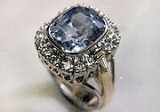
Stonesetting
Encyclopedia
Stonesetting is the art of securely setting or attaching gemstone
s into jewelry. Stonesetting can also be used in referring to setting a stone or orb believed to have magical properties into a staff.
and facet
.
Cabochons, which are smooth, often domed, with flat backs. Agate
s and turquoise
are usually cut this way, but precious stones such as rubies, emerald
s and sapphire
s also may be. Many stones like star sapphires and moonstones
must be cut this way in order to see the effects the stones have in them.
The other type of stone is generically called faceted, in which the stone has the general overall shape of the modern diamond
, with a thin edge, called the girdle, the top angling up into what is called the crown, and the bottom angling down into what is called the pavilion. In the case of a cabochon
stone, the side of the stone is usually cut at a shallow angle, so that when the bezel is pushed over the stone that angle permits it to hold the stone in place and keep it tight. In the case of faceted stones a shallow groove is cut into the side of the bezel into which the girdle of the stone is placed, and then metal is pushed over, holding the stone in place. Cabochons can also be set into prong settings of various kinds, but the idea is the same - it's the prongs going over the angle of the stone that creates the pressure that holds the stone in place.
Just as the angle of the sides of a cabochon
creates the pressure to hold the stone in place, so there is an overlying principle in setting faceted stones. If one looks at a side view of a round
diamond, for example, one will see that there is an outer edge, called the girdle, and the top angles up from there, and the bottom angles down from there. Faceted stones are set by "pinching" that angle with metal. If you imagine holding the girdle with the tips of your thumb and forefinger with both hands, that illustrates it fairly well. All of the styles of faceted stone setting use this concept in one way or another.
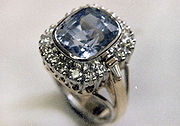 The earliest technique of attaching stones to jewelry was bezel setting. A bezel is a strip of metal bent into the shape and size of the stone and then soldered to the piece of jewelry. Then the stone is inserted into the bezel and the metal rubbed over the stone, holding it in place. This method works well for either cabochon or faceted stones.
The earliest technique of attaching stones to jewelry was bezel setting. A bezel is a strip of metal bent into the shape and size of the stone and then soldered to the piece of jewelry. Then the stone is inserted into the bezel and the metal rubbed over the stone, holding it in place. This method works well for either cabochon or faceted stones.
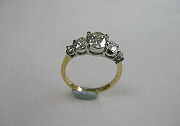 Prong setting is the simplest and most common type of setting, largely because it uses the least amount of metal to hold the stone, thus showing it off to its best advantage. Generally it is simply some number of wires, called prongs, which are of a certain size and shape, arranged in a shape and size to hold the given stone, and fixed at the base. Then a burr
Prong setting is the simplest and most common type of setting, largely because it uses the least amount of metal to hold the stone, thus showing it off to its best advantage. Generally it is simply some number of wires, called prongs, which are of a certain size and shape, arranged in a shape and size to hold the given stone, and fixed at the base. Then a burr
of the proper size, is used to cut what is known as a "bearing", which is a notch that corresponds to the angles of the stone. The burr
most often used is called a "hart bur" that is angled and sized for the job of setting diamonds. That bearing is cut equally into all of the prongs and at the same height above the base. Then the stone is inserted so that it goes into all of the bearings, pliers or a pusher are used to bend the prongs gently over the crown of the stone, and the tops of the prongs are clipped off with snips, filed to an even height above the stone, and finished. Usually a "cup burr" is used to give the prong a nice round tip. A cup burr is in the shape of a hemisphere with teeth on the inside, for making rounded tips on wires and prongs. There are as many variations of prong settings as there are stars in the sky - 2 prongs up to 24 or more, many variations involving decoration, size and shapes of the prongs themselves, and how they are fixed or used in jewelry. But the method of setting is generally the same for all of them.
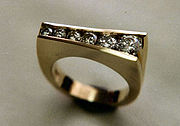 Channel setting is a method whereby stones are suspended between two bars or strips of metal, called channels. Often when setting small stones and the bars go in a linear line with the design it is called channel setting, and when the bars cross the lines of the design, it's called bar set. The idea is the same, though. The channel is some variation of a "U" shape, with two sides and a bottom. The sides are made just a bit narrower than the width of the stone or stones to be set, and then, using the same burs as in prong setting, a small notch, which is again called a bearing, is cut into each wall. The stone is put in place in those notches, and the metal on top is pushed down, tightening the stone in place. The proper way to set a channel is to cut a notch for each stone, but for cheaper production work sometimes a groove is cut along each channel. Also, since the metal can be very stiff and strong, this is a situation where a reciprocating hammer, which is like a jackhammer
Channel setting is a method whereby stones are suspended between two bars or strips of metal, called channels. Often when setting small stones and the bars go in a linear line with the design it is called channel setting, and when the bars cross the lines of the design, it's called bar set. The idea is the same, though. The channel is some variation of a "U" shape, with two sides and a bottom. The sides are made just a bit narrower than the width of the stone or stones to be set, and then, using the same burs as in prong setting, a small notch, which is again called a bearing, is cut into each wall. The stone is put in place in those notches, and the metal on top is pushed down, tightening the stone in place. The proper way to set a channel is to cut a notch for each stone, but for cheaper production work sometimes a groove is cut along each channel. Also, since the metal can be very stiff and strong, this is a situation where a reciprocating hammer, which is like a jackhammer
but jewelry sized, might be used to hammer down the metal, as it can be difficult to do by hand. Then, as always, the metal is filed down and finished, and the inner edge near the stones cleaned up and straightened as necessary. As with all jewelry, there can be many variations of channel work. At times the walls will be raised - sometimes a center stone will be set between two bars that rise high from the base ring - or the channel might just be cut directly into some surface, making the stones flush with the metal. It is still channel setting, though.
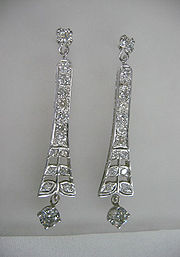
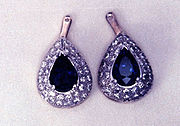 Bead setting is a generic term for setting a stone directly into metal using gravers, also called burin
Bead setting is a generic term for setting a stone directly into metal using gravers, also called burin
s, which are essentially tiny chisels. A hole is drilled directly into the metal surface, and then a ball burr
is used to make a concave depression just the size of the stone. Some setters will set the stone into that concave depression, and some will use a hart burr to cut a bearing around the edge. Then the stone is inserted into that space, and the gravers or burins are used to lift and push a tiny bit of the metal into and over the edge of the stone. Then a beading tool, which is simply a steel shaft with a concave dimple cut into the tip, is pushed onto the bit of metal, rounding and smoothing it, pushing it firmly onto the stone, and creating a "bead". That is the essential method, but there are many types of setting that use the technique. When many stones are set in this fashion very closely together, covering a surface, that is called "pavé" - from the French for paved or cobblestoned. When a long line is engraved into the metal going up to each of the beads, that is "star set", because of the look. The other common usage is called "bead and bright", "grain setting" or "threading" in Europe, and other names at times. This is when, after the stone is set as described above, the background metal around the stone is cut away, usually in geometric shapes. In the end what is left is the stone with four beads in a lowered box shape with an edge around it. Often it is a row of stones, so it will be in a long shape with a raised edge and a row of stones and beads down the center. This type of setting is still used often, but it was very common in the early to middle 20th century.
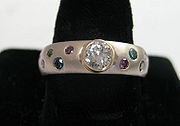 Burnish setting or flush setting is similar to bead setting, but after the stone is inserted into the space, instead of using a graver to lift beads, a rubbing tool is used to push the metal all around onto the stone, not very different from bezel setting. The stone will be roughly flush with the surface, with a nice rubbed edge around it. This is a fairly recent type of setting, looks very contemporary, and the metal is often finished using sandblasting, as it shows off the work very well.
Burnish setting or flush setting is similar to bead setting, but after the stone is inserted into the space, instead of using a graver to lift beads, a rubbing tool is used to push the metal all around onto the stone, not very different from bezel setting. The stone will be roughly flush with the surface, with a nice rubbed edge around it. This is a fairly recent type of setting, looks very contemporary, and the metal is often finished using sandblasting, as it shows off the work very well.
Gemstone
A gemstone or gem is a piece of mineral, which, in cut and polished form, is used to make jewelry or other adornments...
s into jewelry. Stonesetting can also be used in referring to setting a stone or orb believed to have magical properties into a staff.
Cabochon and facet
There are two general types of gemstone cutting: cabochonCabochon
A cabochon , from the Middle French caboche , is a gemstone which has been shaped and polished as opposed to faceted. The resulting form is usually a convex top with a flat bottom. Cutting en cabochon is usually applied to opaque gems, while faceting is usually applied to transparent stones...
and facet
Facet
Facets are flat faces on geometric shapes. The organization of naturally occurring facets was key to early developments in crystallography, since they reflect the underlying symmetry of the crystal structure...
.
Cabochons, which are smooth, often domed, with flat backs. Agate
Agate
Agate is a microcrystalline variety of silica, chiefly chalcedony, characterised by its fineness of grain and brightness of color. Although agates may be found in various kinds of rock, they are classically associated with volcanic rocks and can be common in certain metamorphic rocks.-Etymology...
s and turquoise
Turquoise
Turquoise is an opaque, blue-to-green mineral that is a hydrous phosphate of copper and aluminium, with the chemical formula CuAl648·4. It is rare and valuable in finer grades and has been prized as a gem and ornamental stone for thousands of years owing to its unique hue...
are usually cut this way, but precious stones such as rubies, emerald
Emerald
Emerald is a variety of the mineral beryl colored green by trace amounts of chromium and sometimes vanadium. Beryl has a hardness of 7.5–8 on the 10 point Mohs scale of mineral hardness...
s and sapphire
Sapphire
Sapphire is a gemstone variety of the mineral corundum, an aluminium oxide , when it is a color other than red or dark pink; in which case the gem would instead be called a ruby, considered to be a different gemstone. Trace amounts of other elements such as iron, titanium, or chromium can give...
s also may be. Many stones like star sapphires and moonstones
Moonstone (gemstone)
Moonstone is a sodium potassium aluminium silicate, with the chemical formula AlSi3O8.-Etymology:Its name is derived from a visual effect, or sheen, caused by light reflecting internally in the moonstone from layer inclusion of different feldspars....
must be cut this way in order to see the effects the stones have in them.
The other type of stone is generically called faceted, in which the stone has the general overall shape of the modern diamond
Diamond
In mineralogy, diamond is an allotrope of carbon, where the carbon atoms are arranged in a variation of the face-centered cubic crystal structure called a diamond lattice. Diamond is less stable than graphite, but the conversion rate from diamond to graphite is negligible at ambient conditions...
, with a thin edge, called the girdle, the top angling up into what is called the crown, and the bottom angling down into what is called the pavilion. In the case of a cabochon
Cabochon
A cabochon , from the Middle French caboche , is a gemstone which has been shaped and polished as opposed to faceted. The resulting form is usually a convex top with a flat bottom. Cutting en cabochon is usually applied to opaque gems, while faceting is usually applied to transparent stones...
stone, the side of the stone is usually cut at a shallow angle, so that when the bezel is pushed over the stone that angle permits it to hold the stone in place and keep it tight. In the case of faceted stones a shallow groove is cut into the side of the bezel into which the girdle of the stone is placed, and then metal is pushed over, holding the stone in place. Cabochons can also be set into prong settings of various kinds, but the idea is the same - it's the prongs going over the angle of the stone that creates the pressure that holds the stone in place.
Just as the angle of the sides of a cabochon
Cabochon
A cabochon , from the Middle French caboche , is a gemstone which has been shaped and polished as opposed to faceted. The resulting form is usually a convex top with a flat bottom. Cutting en cabochon is usually applied to opaque gems, while faceting is usually applied to transparent stones...
creates the pressure to hold the stone in place, so there is an overlying principle in setting faceted stones. If one looks at a side view of a round
Brilliant (diamond cut)
A brilliant is a diamond or other gemstone, cut in a particular form with numerous facets so as to have exceptional brilliance. The shape resembles that of a cone and provides maximized light return through the top of the diamond....
diamond, for example, one will see that there is an outer edge, called the girdle, and the top angles up from there, and the bottom angles down from there. Faceted stones are set by "pinching" that angle with metal. If you imagine holding the girdle with the tips of your thumb and forefinger with both hands, that illustrates it fairly well. All of the styles of faceted stone setting use this concept in one way or another.
Types of stonesetting
There are thousands of variations of setting styles, but there are several fundamental types:Bezel setting

Prong setting

Burr (cutter)
Burrs are small cutters used in die grinders, rotary tools or dentist's drills. The name may be considered appropriate when their small sized head is compared to that of a seed of the burr fruit or the teeth compared to a metal burr.To maintain the correct surface speed and cutting conditions...
of the proper size, is used to cut what is known as a "bearing", which is a notch that corresponds to the angles of the stone. The burr
Burr (cutter)
Burrs are small cutters used in die grinders, rotary tools or dentist's drills. The name may be considered appropriate when their small sized head is compared to that of a seed of the burr fruit or the teeth compared to a metal burr.To maintain the correct surface speed and cutting conditions...
most often used is called a "hart bur" that is angled and sized for the job of setting diamonds. That bearing is cut equally into all of the prongs and at the same height above the base. Then the stone is inserted so that it goes into all of the bearings, pliers or a pusher are used to bend the prongs gently over the crown of the stone, and the tops of the prongs are clipped off with snips, filed to an even height above the stone, and finished. Usually a "cup burr" is used to give the prong a nice round tip. A cup burr is in the shape of a hemisphere with teeth on the inside, for making rounded tips on wires and prongs. There are as many variations of prong settings as there are stars in the sky - 2 prongs up to 24 or more, many variations involving decoration, size and shapes of the prongs themselves, and how they are fixed or used in jewelry. But the method of setting is generally the same for all of them.
Channel setting

Jackhammer
A jackhammer is a pneumatic tool that combines a hammer directly with a chisel that was invented by Charles Brady King. Hand-held jackhammers are typically powered by compressed air, but some use electric motors. Larger jackhammers, such as rig mounted hammers used on construction machinery, are...
but jewelry sized, might be used to hammer down the metal, as it can be difficult to do by hand. Then, as always, the metal is filed down and finished, and the inner edge near the stones cleaned up and straightened as necessary. As with all jewelry, there can be many variations of channel work. At times the walls will be raised - sometimes a center stone will be set between two bars that rise high from the base ring - or the channel might just be cut directly into some surface, making the stones flush with the metal. It is still channel setting, though.
Bead setting


Burin
Burin from the French burin meaning "cold chisel" has two specialised meanings for types of tools in English, one meaning a steel cutting tool which is the essential tool of engraving, and the other, in archaeology, meaning a special type of lithic flake with a chisel-like edge which was probably...
s, which are essentially tiny chisels. A hole is drilled directly into the metal surface, and then a ball burr
Burr (cutter)
Burrs are small cutters used in die grinders, rotary tools or dentist's drills. The name may be considered appropriate when their small sized head is compared to that of a seed of the burr fruit or the teeth compared to a metal burr.To maintain the correct surface speed and cutting conditions...
is used to make a concave depression just the size of the stone. Some setters will set the stone into that concave depression, and some will use a hart burr to cut a bearing around the edge. Then the stone is inserted into that space, and the gravers or burins are used to lift and push a tiny bit of the metal into and over the edge of the stone. Then a beading tool, which is simply a steel shaft with a concave dimple cut into the tip, is pushed onto the bit of metal, rounding and smoothing it, pushing it firmly onto the stone, and creating a "bead". That is the essential method, but there are many types of setting that use the technique. When many stones are set in this fashion very closely together, covering a surface, that is called "pavé" - from the French for paved or cobblestoned. When a long line is engraved into the metal going up to each of the beads, that is "star set", because of the look. The other common usage is called "bead and bright", "grain setting" or "threading" in Europe, and other names at times. This is when, after the stone is set as described above, the background metal around the stone is cut away, usually in geometric shapes. In the end what is left is the stone with four beads in a lowered box shape with an edge around it. Often it is a row of stones, so it will be in a long shape with a raised edge and a row of stones and beads down the center. This type of setting is still used often, but it was very common in the early to middle 20th century.
Burnish setting


